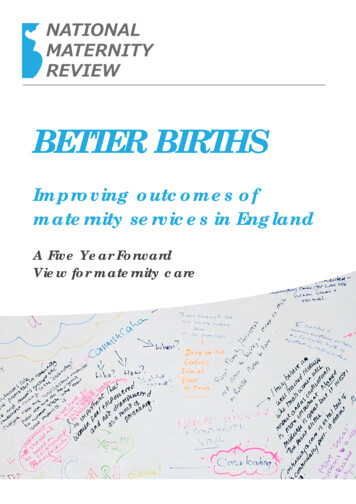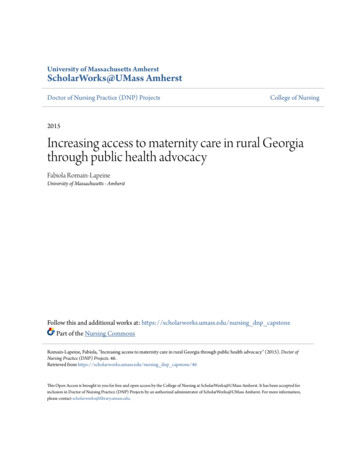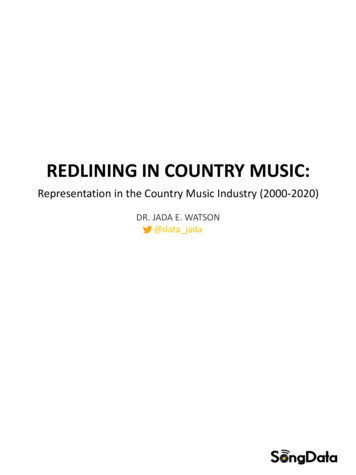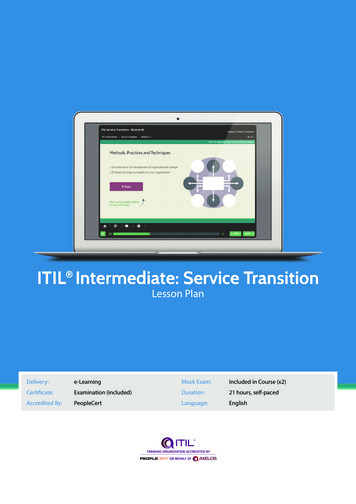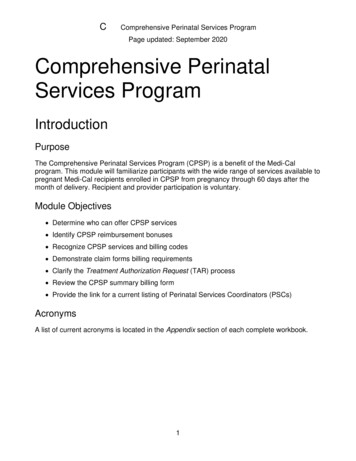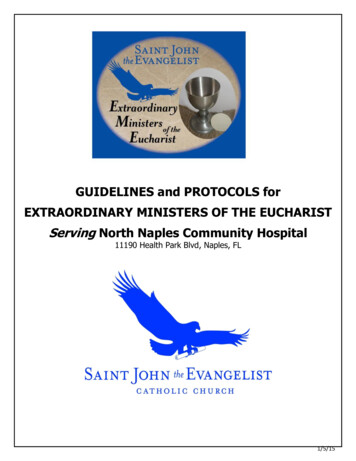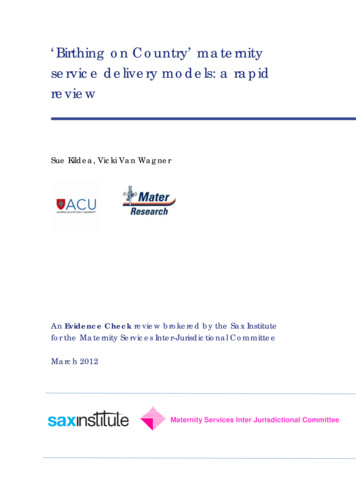
Transcription
‘Birthing on Country’ maternityservice delivery models: a rapidreviewSue Kildea, Vicki Van WagnerAn Evidence Check review brokered by the Sax Institutefor the Maternity Services Inter-Jurisdictional CommitteeMarch 2012Maternity Services Inter Jurisdictional Committee
This rapid review was brokered by the Sax Institute for the Maternity Services Inter-Jurisdictional Committee,and was funded by the Australian Health Ministers’ Advisory Council.This report was prepared by:Sue Kildea1, Vicki Van Wagner21. Director, Midwifery Research Unit, Australian Catholic University and Mater Medical Research Institute2. Associate Professor, Midwifery, Ryerson University, Toronto Ontario, CanadaMarch 2012 Sax Institute 2013This work is copyright. No part may be reproduced by any process except in accordance with the provisionsof the Copyright Act 1968.Enquiries regarding this report may be directed to:Knowledge Exchange ProgramSax InstituteLevel 2, 10 Quay Street Haymarket NSW 2000PO Box K617 Haymarket NSW 1240 AustraliaT: 61 2 95145950F: 61 2 95145951Email: knowledge.exchange@saxinstitute.org.auSuggested Citation:Kildea S, Van Wagner V. ‘Birthing on Country’ maternity service delivery models: an Evidence Check rapidreview brokered by the Sax Institute (http://www.saxinstitute.org.au) on behalf of the Maternity Services InterJurisdictional Committee for the Australian Health Ministers’ Advisory Council: Sydney, 2013.Disclaimer:This Evidence Check review was produced using the Evidence Check methodology in response to specificquestions from the commissioning agency. It is not necessarily a comprehensive review of all literature relatingto the topic area. It was current at the time of production (but not necessarily at the time of publication). It isreproduced for general information and third parties rely upon it at their own risk.
CONTENTSEXECUTIVE SUMMARY . 5Background . 5Methods. 5Results . 5Review question 1 . 6Review question 2 . 8Review question 3 . 9Conclusion . 111Background . 13Policy background . 14This review. 142Methods . 163Results . 18Review question 1. . 18Review question 2. . 22Review question 3. . 244Conclusions and recommendations . 285References . 306Appendices. 35Appendix 1.Glossary of terms . 35Appendix 2. Action 2.2.3. National Maternity Plan 2011 . 37Appendix 3. Level of evidence . 37Appendix 4. Database search information . 39Appendix 5. Components of Birthing on Country models . 40Appendix 6. Evaluation of the Birthing on Country models . 50
EXECUTIVE SUMMARYBackgroundThe National Maternity Services Plan1 was endorsed by the Australian Health Ministers in 2010.Action 2.2 of this Plan aims to: Develop and expand culturally competent maternity care forAboriginal and Torres Strait Islander people. A key deliverable is Action 2.2.3: To undertakeresearch into international evidence-based examples of Birthing on Country programs to informthe development and implementation of a national Birthing on Country service delivery modelthat is culturally competent and improves health outcomes for Aboriginal and Torres StraitIslander mothers and babies. For the purposes of this review ‘Birthing on Country’ was defined as:maternity services designed and delivered for Indigenous women that encompass some or all ofthe following elements: are community based and governed; allow for incorporation oftraditional practice; involve a connection with land and country; incorporate a holistic definitionof health; value Indigenous and non-Indigenous ways of knowing and learning; risk assessmentand service delivery; are culturally competent; and developed by, or with, Indigenous people.This review is limited to Indigenous communities of developed countries such as Australia, NewZealand, Canada, and the United States of America. The review questions were:1.What are the components of maternity service delivery models that have beenimplemented for Indigenous mothers and babies?2.Which of these models have been most effective? And why? (Only include models thathave been evaluated)3.What have been the barriers and facilitators of the successful implementation andsustainability of these models? And why? Were the barriers resolved?MethodsA search strategy utilised 17 databases to identify 2,413 English language articles/reportspublished from 1985 to November 2011 (Appendix 2). Titles were reviewed to ascertain potentialrelevance with 362 abstracts downloaded and 200 full text articles/reports kept on file. Of these,165 were considered relevant to the topic (2 reviewers); with 95 chosen for review inclusion (2reviewers). Of these, only 18 involved evaluations of services that were deemed to have highrelevance to the review questions. The highest level of evidence attained by any study was III-2(Appendix 3). Most of the 18 evaluations were from Australia (n 13). The largest study was aCanadian study and there was only one from the United States and none from New Zealand.ResultsThere is a dearth of high quality research in this area. Most studies were limited by small numbers,short-term evaluation data and a lack of comparison data. Interventions have often been basedon research that has improved maternal infant health (MIH) outcomes in other populations withvariable success. Interventions have often been multi-faceted making evaluations complex. Awidespread desire to see measurable changes in MIH outcomes, coupled with a relatively shortSax Institute5
EXECUTIVE SUMMARYtime frame, and/or insufficient funding for evaluation has at times led to claims that are likely tobe overstating program effectiveness. This is not to say that the effectiveness would not beevident if there was a longer timeframe for the evaluation. There was little evidence to link theinterventions to the outcomes in some studies; and attempts to replicate the findings in othersites, has not always been successful. Limitations were often due to the retrospective nature ofsome of the study designs.The wide variation in design, reported outcome data and quality make it difficult to combineresults to draw conclusions. Two previous reviews have highlighted the common factorsassociated with successful programs, which were aimed at improving Aboriginal and Torres StraitIslander MIH in Australia.2,3 Broadening this review to include other countries has added valuableinformation with the largest study included being conducted in the remote Inuit setting. This studyis also the only one that could be seen to meet all criteria in the review definition of Birthing onCountry. Applicability to the Australian setting is likely. Although there is some difference betweenthe Inuit and Australian Aboriginal communities the similarities are striking. Both are vast countrieswith small Indigenous communities scattered across remote areas that become isolated in badweather. Living conditions and literacy and numeracy rates in the remote Canadiancommunities are not dissimilar to Australian remote communities. Recognition of this has led to acompetency-based approach to training and the development of a career pathway that startswith unskilled maternity workers employed in the model and paid time for training andeducation. The onsite midwifery training is considered essential to the success and sustainabilityof this model.The review yielded the following information in answer to the review questions.Review question 1What are the components of maternity service delivery models that have been implemented forIndigenous mothers and babies?In summary, the list below builds on the key elements of successful programs identified previously2to answer Review question 1. Not all services had all components however the following overviewpresents the ones that were more often associated with success.Governance and ownership Aboriginal leadership and control (though this was not associated with all the successfulservices it appears very important in some) Collaborative community development approach to establishment with strongleadership, shared vision and commitment of staff Aboriginal advocacy group involved for cultural guidance and oversight (remuneratedand roles described) Clinical governance framework.Philosophy6 Respect for Aboriginal and Torres Strait Islander people and their culture; and integrationof local Indigenous knowledge with western knowledge within an effective partnershipapproach A service that values connection to land and country Overarching philosophy of ‘women’s business’Sax Institute
EXECUTIVE SUMMARY Respect for family involvement, including men (some services), in health and caring forchildren Continuity of care and provision of known caregivers across the continuum of careincluding antenatally, in labour; and in some cases in the first year of the infantslife/continuing care even when the woman moves out of area/a focus on relationships Valuing Aboriginal and Torres Strait Islander staff, and female staff, with localemployment that takes a capacity building approach and incorporates mentoring,training and education A holistic definition of health, thus providing a broad spectrum of services that integratewith other services (e.g. hospital liaison, allied health, child health, general medicalpractice) and link directly into tertiary service if required.Service characteristics Culturally competent service and staff Community based A specific service location intended for women and children Designated ongoing funding for the service A welcoming and safe service environment with flexibility in service delivery andappointment times; a focus on communication, relationship building and developmentof trust A service that provides high quality care integrated with other services and incorporatesoutreach activities, home visiting with follow-up care, provision of transport, childfriendly/care, mothers groups, parenting classes targeting young women, postnataldepression support group, playgroups, early intervention and prevention including briefinventions, 24 hour call, early childhood care and family orientation to services A risk screening process that is seen as a social, cultural, and community process ratherthan simply a biomedical one; with risk assessment criteria and interdisciplinary perinatalcommittee Effective information technology services Integrated with tertiary services with clear referral pathways and formalised networks.Training and education A partnership approach incorporating ‘two way learning’ Having an appropriately trained workforce with support from interdisciplinary team Competency-based approach to training, with a career pathway that starts withunskilled maternity workers employed in the model that receives on-site training in MIHand midwifery.Monitoring and evaluation Designated funding for monitoring and evaluation Continuous quality assurance framework Audit activities that include a recall register.Sax Institute7
EXECUTIVE SUMMARYThe figure below provides a graphical presentation of these key points.Birthing on CountryMaternity services designed and delivered for Indigenous womenGovernanceIndigenous control, community development approach, shared vision, cultural guidance and oversightPhilosophyRespect for Indigenous knowledge and incorporation of traditional practice / Respect for family involvement /Partnership approach / Women’s Business / Continuity of carer / Capacity building approach – particularlywith training and education / Holistic definition of healthTraining &EducationPartnership approach/ 2-way learning;Appropriately trainedand supported;Competency based;Delivered on-site;Career pathway frommaternity workers tomidwiferyService CharacteristicsCulturally competent service and staff;Community based; Specific location;Designated ongoing funding; Welcomingflexible service focusing on relationshipsand trust; Outreach, transport, childfriendly and group sessions; Social, cultural,biomedical and community risk assessmentcriteria; Interdisciplinary perinatalcommittee; Effective IT; Integrated withtertiary servicesMonitoring &EvaluationDesignatedfunding formonitoring andevaluation;Continuousquality assurance;audit activitiesand recall registerResultsCommunity healing as evidenced by: Reduced family separation at critical times, restoration of skills andpride; Capacity building in the community; Supporting community and family relationships; Reduced familyviolence; Increased communication and liaison with other health professionals and service providers;Comprehensive, holistic, tailored care.Improved Maternal and Infant Health OutcomesFigure 1. Components of maternity service delivery models for Indigenous mothers and babiesReview question 2Which of these models have been most effective? And why?The most effective Birthing on Country model reported in the literature is the Inuulitsivik MidwiferyService. It is the only model that met all criteria in the review definition. It is a community basedand Inuit-led initiative on the Hudson coast of the Nunavik region of northern Quebec.4,5 Theservice supports on-site birthing centres and midwifery training in three remote communities,many hours from a caesarean section facility. It commenced if the first community in 1986, is asustainable model, and has excellent MIH outcomes.The key factors thought to contribute to its success include:8 Inuit leadership – the Board of the Inuulitsivik Health Centre is Inuit Community involvement – the service was initiated by, and is strongly supported by, thecommunity Midwifery-led care for all women and newbornsSax Institute
EXECUTIVE SUMMARY Broad scope of practice for midwives including community health and emergency skills(the scope is similar to the scope of practice of remote area nurse midwives in Australia) Local education of midwives ensuring that care is provided within culture and languageand is sustainable Local students supported financially and seen as valuable team members Seeing local birth as an improved health outcomes in and of itself Integrating Indigenous and non-Indigenous approaches to birth Local culture of normal birth supported by midwifery with use of technology as neededto maximise safe birth in the community Collaboration with ‘southern’ (non-Inuit) midwives and midwifery organisations Collaboration with the health care team i.e. local and tertiary physicians and local nurses Risk assessment in a cultural and social context.This model is described in detail in the report. Although this model is in Canada, the context,geography and challenges have more similarities with the remote Australian setting than manyurban Australian settings have.Review question 3What have been the barriers and facilitators of the successful implementation and sustainabilityof these models? And why? Were the barriers resolved?The key facilitators for the success and sustainability of programs are identified under reviewquestion one. The barriers to implementation and sustainability are addressed below using thesame categories as those described in Review question 1. We provide some examples of howthese have been overcome.Governance Facilitating community participation and control of programs can be challenging. Cleardocumentation and consensus on the governance structure assists the process, as doesappropriate remuneration to members, and the provision of transport and other logisticalsupport. At Inuulitsivik there is an Inuit Board and the midwives are integrated into thegovernance structures. A council of physicians, dentists, pharmacists and midwives setclinical policy for the community hospital and health centres in each of the communities.Knowledge base and philosophy The blending of Indigenous and western approaches to knowledge and care in ameaningful way that legitimises Indigenous knowledge is a challenging area. This requiresongoing Indigenous involvement in governance, leadership and evaluation; and requiresacknowledgement and incorporation of social and cultural risk. Local education ofAboriginal midwives and maternity workers that incorporates learning about Indigenousapproaches to birth is key. All midwifery education programs need to teach skills ofcultural safety and competency/ two way working Working in partnership and providing a capacity building approach increases the scopeof programs and makes them more costly to run. Many midwives have not worked in thisway before and skilled knowledgeable clinicians are not always effective educators.Additionally, the international definition of a midwife and the competency standardsrequired for providers of clinical maternity care in Australia become challenging pointsSax Institute9
EXECUTIVE SUMMARYThis seems particularly so with the introduction of new MIH workers (Aboriginal MIHworker, Aboriginal Maternal Infant Care Worker, Aboriginal Health Worker), andparticularly in tertiary hospitals. Role delineation, competency standards and scope ofpractice are not always clear with different training programs across the country.Consensus and clear documentation of program philosophy, scope and roles at all levelsshould be undertaken as collaborative project with all team members The overarching ‘Women’s Business’ philosophy is a dynamic concept requiring localinterpretation. Some services have remained ‘women only’ but are finding that youngerwomen are increasingly wanting their partners present and involved in care. Manycontinue to report a preference for female care providers however some suggest thatrelationships of trust are more important than gender of caregiver Continuity of carer through the birthing episode is difficult when MIH services are based innon-government organisations; or women relocate for birth. Several models are workingtowards the provision of this. In Alice Spring the Aboriginal Medical Service has a MOUwith the hospital with access agreements to assist staff to move with the women. A newmodel in Darwin (currently being evaluated and not yet published or reported on here)provides continuity of carer for women from remote settings any time they have to travelto town for birth. The team consist of midwives, Aboriginal health workers/studentmidwives, Strong Women Workers and a senior Aboriginal women, a coordinator andadministration officer. Continuity of obstetric oversight is more challenging.Organisation and delivery of services There must be sufficient, appropriate and ongoing funding for service delivery,monitoring and evaluation. Often the demand and perceived need is for a broaderscope of services than what is provided, or budgeted for. A clear understanding of, anddocumented, program scope should be available to staff and service users alike Providing a wide spectrum of services is challenging with many services stating that childhealth and social work services should be integral to the program The structural and logistical difficulties of providing continuity of carer when based in thecommunity or non-government organisations need to be addressed practically and inways that are acceptable to the staff and community; and are cost effective. This mayinclude overarching MOUs, regular meetings, increased use of IT facilitated orteleconference case management meetings. Very few are utilising videoconferencingfacilities or software programs such as Skype effectively There can be high administration workloads with insufficient time taken for effective intercultural working, inter-agency networking, and collaboration. Case management canbe onerous and time required often underestimated, especially if interagency support(e.g. housing) is required Scope of practice issues must be addressed with clear role delineation of all workers High staff turnover is mentioned as a challenging area across many of the reports. This isone of the reasons that communities have commenced local training and education(addressed below).Training and education 10There must be; appropriate sustained support for Indigenous women to undertake MIHtraining and become midwives. For non-Indigenous staff there are often difficultiesunderstanding ‘two way working’. Resistance by some hospital staff to culturallyresponsive care has been documented, and is expressed in institutional racism. This canbe also expressed in logistical issues, for example, a lack of resources or a designatedspace for Indigenous workersSax Institute
EXECUTIVE SUMMARY Non-Indigenous staff need training and support to understand the roles of Indigenousworkers in their own right; with their own knowledge system. Some programs havehighlighted a lack of understanding resulting in Indigenous workers being designated‘taxi drivers’ for the women or ‘midwifery assistants’ Family and cultural commitments for Indigenous workers can make regular attendancechallenging. Flexible employment models could overcome this but few have adoptedan annualised salary approach for all staff members (usually only the midwives).Monitoring and evaluation Data collection and the methods used must meet the needs of the service for ongoingmonitoring and evaluation. The routine minimum perinatal data collection acrossAustralia is insufficient to report on these models, or monitor the quality of these services.Many are devising their own databases or spreadsheets for local analysis.Successful programs The successful programs have managed to overcome some or all of these barriers, oftenwith local innovation and leadership from committed people. There are examples ofsuccessfully identifying supplementary funding sources and negotiating support andservices at a multi-agency level. Services that have been built from the ground up seemto have remained sustainable. The challenge of distance has been overcome by carefulrisk screening and a broad role and scope of practice for midwives. Workforcechallenges have been overcome by training locally and taking a long-term approach.ConclusionThe review of the literature has shown that improvements in key MIH indicators can be realisedthrough service redesign. Improvements in antenatal indicators, quality and quantity of care, MIHoutcomes and service user satisfaction were evident. Active participation of the woman and herfamily in care suggest a service that is culturally responsive and key factors associated with thiswere continuity of carer, and known caregivers across the continuum of care including in labour;and in some cases in the first year of the infant’s life. Broader roles for both AHW’s and midwiveswere supported in some programs with Indigenous workers being a key factor in theacceptability of services. Involvement of Indigenous elders and services that were developedwith the community, or by the community, were particularly well attended and appearsustainable. Incorporation of traditional midwifery knowledge and skills were considered essentialto the success of some of these services. The importance of all stakeholders being aware of thelimitation of the services from the beginning was acknowledged as being essential. The benefitsof community-based birthing services, over and above the improvements in MIH outcomes,include: Community ‘healing’ Reduced family separation at critical times Reduced family violence Restoration of skills and pride Capacity building in the community Local training and employment Supporting community and family relationships Increased communication/liaison with other health professionals and service providersSax Institute11
EXECUTIVE SUMMARY Comprehensive, holistic, tailored care.In conclusion, the available evidence suggests that a Birthing on Country model of maternitycare would most likely produce significantly improved MIH outcomes for Aboriginal and TorresStrait Islander women. The available evidence would support these models being established inany area; very remote, remote, rural, regional or urban. However, many people find the Birthingon Country terminology challenging and do not have a clear understanding of what it wouldmean or could look like. The risk associated with using this terminology is that there may be a lackof engagement from key service providers or government departments. This should be discussedat the workshop planned for later in the year. It is clear that a strong research and evaluationframework should be used to be able to report on the process, impact and outcomes of anysuch developments. Ideally, this would involve a longitudinal design that provides robustevidence and enables identification of the key factors for success, or failure; and clearly outlineshow barriers and challenges are overcome. Key components could be developed into aminimum standards document that outlines the overarching governance structure; culturalcompetencies and requirements; core principles; recommendations for community liaison andparticipation; minimum resource, infrastructure and equipment requirements; staff competencyrequirements; support, training and education requirements; minimum data collectionrequirements with regular quality assurance audit and evaluation which incorporates serviceusers views of the service; and risk assessment criteria. Additionally, a need for secure funding ofthe services and their evaluation over time is essential.12Sax Institute
1 BackgroundThe Indigenous populations of developed countries have lower living standards, higher rates ofmortality and morbidity, greater risk factors for disease and poorer reproductive health outcomeswhen compared with their non-Indigenous counterparts; particularly those living in rural andremote areas.6,7,8 There are many contributing factors including: the enduring effects ofcolonisation, reflected in a higher burden of disease; and poverty, reflected in poor housing, lackof employment and reduced access to services.9,10,11 However, the disparities in outcomesbetween Indigenous and non-Indigenous Australians are wider than they are in comparablecountries such as Canada, United States and New Zealand.6,7In Australia, significantly higher maternal and perinatal morbidity and mortality rates existamongst the former group, for example maternal mortality (up to 5.3 times greater)12, low birthweight infants (liveborn infants: 12.3% vs. 5.9%); preterm births (13.3% vs. 8.0%); and perinataldeaths (17.3 vs. 9.7 per 1,000) are all higher than their non-Indigenous counterparts.13 Risk factorsfor poor outcomes are much higher amongst Aboriginal and Torres Strait Islander womencompared to non-Indigenous women, for example, teenage pregnancy (20.5% vs 3.5%) andsmoking in pregnancy (50.9% vs 14.4%).13The National Strategic Framework for Aboriginal and Torres Strait Islander Health proposes aunified, comprehensive approach to reducing disadvantage and closing the gap in healthoutcomes between Indigenous and non-Indigenous Australians.14 Six targets, selected asessential elements in closing the gap, and a number of strategic areas for action were identified,alongside a reporting framework. The key indicators for improving MIH include: improvedantenatal care provision, alcohol and smoking reduction in pregnancy, reducing the rate of lowbirth weight babies, reducing the rate of teenage pregnancy and birth, and addressing thecauses of maternal mortality and early childhood hospitalisations.14 The most recent HealthPerformance Framework Report shows that despite improvements in some areas (34% decline inperinatal mortality between 1999–2008), we are yet to see the expected improvements resultingfrom the ‘Close the Gap’ Campaign.9Whilst some indicators for the
widespread desire to see measurable changes in MIH outcomes, coupled with a relatively short : Sax Institute 5 : EXECUTIVE SUMMARY . time frame, and/or insufficient funding for evaluation has at times led to claims that are likely to be overstating program effectiveness. This is not to say that the effectiveness would not be
